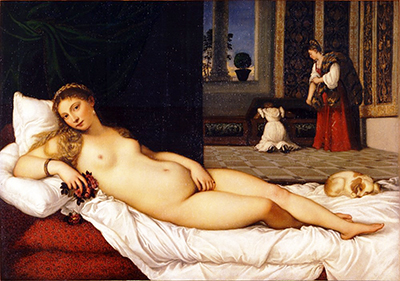The Venus of Urbino was painted by Titian in 1538 and has become one of the most well known nude paintings in the world. Today it remains one of the popular exhibits in the Uffizi Gallery in Florence and is considered a remarkable piece of renaissance art.
The picture was painted for Guidobaldo della Rovere, the Duke of Camerino, later the Duke of Urbino, probably to commemorate his marriage to Giuliana Varano. Painted in oil on canvas the picture depicts a nude woman, reclining among silken sheets.
The picture is similar in its composition to the 1510 Sleeping Venus by Giorgione, a painting which was completed after the artist's death by Titian himself. However there are marked differences. Giorgione's Venus is sleeping and unobtainable, lost in her own dream of love. However Titian's is awake and looking out at the viewer in an inviting fashion.
The setting too is different. The Sleeping Venus is outside, while the Venus of Urbino is in the more intimate setting of a bedchamber in a sumptuous palace. Behind the woman the more public part of the palace can be seen, but the Venus, herself, is concealed from that part by a screen and is for the eyes of the viewer only.
While the painting is erotic in nature, it does not portray a courtesan. Instead it is believed to depict an ideal of marital love and intimacy. There are a number of features in the painting which would suggest that to be the case. The roses in the right hand of the woman are a commonly used symbol of love to this day, while the dog curled up at her feet is a symbol of fidelity.
In the background two maids can be seen looking in a chest, suggesting a domestic setting, while the youth of the girl rummaging in the chest suggests motherhood. It is likely the chest is a cassone, which is where the new bride would keep her trousseaux.
Venus, the goddess of love and fertility, here is shown as a model of the physical love between a man and wife and the picture may have been intended to set an example to the young wife of the Duke. Although the woman does not immediately appear as the Venus of classical mythology, both the roses in her hand and the myrtle silhouetted against the sky are both symbols traditionally associated with the goddess.
Titian (Tiziano Vecelli) was born around the year 1488 and was one of the great masters of Venetian renaissance art, particularly for his use of colour. In the Venus of Urbino this can be seen in the vivid colours of the background figures, as well as the delicate, warm tones of the woman with the light enhancing both her body and the silky sheets.
Much of the strength of its composition is owed to its use of contrasts. The light on the woman's skin, contrasts with the darker background, while the straight lines of the tiles and dividing screen enhance the voluptuous curves of her body.
Titian's skill as an artist was recognized during his lifetime and his works which included not only portraits, but landscapes, religious paintings and mythological art, were much sought after by the nobility of the day. He died in 1576 and has remained an inspiration for many generations of artists.




